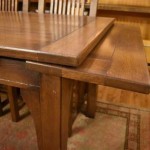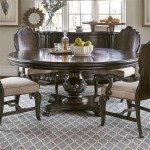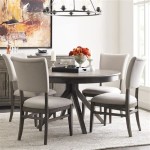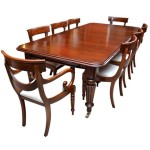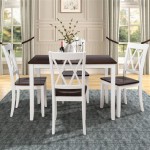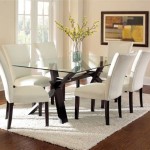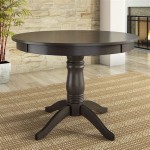Round Rug Under Square Dining Table: A Design Guide
Pairing a round rug with a square dining table might seem counterintuitive, but this combination can create a visually appealing and dynamic dining space. The contrast in shapes adds an element of unexpectedness and softens the rigid lines of a square table, contributing to a more relaxed and inviting atmosphere. Understanding the key principles of size, placement, and material will ensure a successful integration of these two distinct shapes.
The primary consideration when selecting a round rug for a square dining table is size. The rug should be large enough to accommodate the table and chairs comfortably, even when pulled out for use. A general rule of thumb is to add at least 24 inches to each side of the table's dimensions. This ensures that the chair legs remain on the rug when guests are seated, preventing a tripping hazard and maintaining a cohesive visual flow.
For example, a 48-inch square dining table would require a round rug with a diameter of at least 96 inches (48 + 24 + 24). This allows ample space for chairs to be pulled out without the back legs falling off the rug. Larger rugs can further enhance the sense of spaciousness and anchor the dining area more effectively within a larger room.
Placement is equally important. The rug should be centered under the table, creating a balanced and symmetrical arrangement. The circular shape of the rug helps to define the dining area as a distinct zone within an open-plan living space. Ensuring that the rug extends equally on all sides of the table contributes to a harmonious visual balance.
Choosing the right material depends on the overall aesthetic and practical considerations. High-traffic areas like dining rooms benefit from durable, easy-to-clean materials. Wool rugs offer excellent durability, stain resistance, and a soft texture underfoot. Synthetic fibers like polypropylene and nylon are cost-effective alternatives that are also resistant to stains and wear.
Natural fiber rugs, such as jute and sisal, can add a touch of rustic charm and texture to a dining space. However, they can be more challenging to clean and may not be suitable for homes with pets or young children. Consider the lifestyle and needs of the household when selecting a rug material.
The color and pattern of the rug also play a significant role in the overall design scheme. A neutral-colored rug can create a calming backdrop for a more vibrant dining set, while a patterned rug can add visual interest and personality to the space. Consider the existing color palette and décor style when choosing a rug that complements the overall aesthetic.
For a cohesive look, consider echoing the rug's color or pattern in other elements within the dining area, such as cushions, curtains, or artwork. This creates a sense of visual continuity and reinforces the design theme. Alternatively, a contrasting rug can create a focal point and add a touch of drama to the space.
In rooms with hardwood or tile floors, a rug provides warmth and comfort underfoot, making the dining area more inviting. It also helps to absorb sound, reducing noise levels and creating a more peaceful dining experience. This is particularly beneficial in open-plan living spaces where noise can easily travel between different zones.
The combination of a round rug and a square dining table offers a compelling contrast that adds visual interest and softens the sharp lines of the table. By carefully considering the size, placement, material, color, and pattern of the rug, one can create a harmonious and stylish dining space that enhances the overall aesthetic of the room.
Beyond aesthetics, a rug under the dining table also provides practical benefits. It protects the flooring from scratches and spills, particularly in high-traffic areas like dining rooms. This is especially important for delicate flooring materials such as hardwood or tile.
Furthermore, a rug can help to define the dining area within a larger open-plan space, creating a visual separation between different functional zones. This helps to create a sense of order and organization within the room, making it feel more cohesive and well-defined.
When selecting a round rug for a square dining table, it is helpful to visualize the space and consider how the rug will interact with other elements in the room. Using online room planning tools or creating a physical mock-up with painter's tape can assist in determining the optimal rug size and placement.
Ultimately, the choice of a round rug under a square dining table is a design decision that depends on individual preferences and the specific characteristics of the space. By understanding the key principles of size, placement, and material selection, one can confidently choose a rug that complements the dining table and enhances the overall aesthetic of the room.

Rules Of Thumb For Rugs Under Round Dining Tables Inspiration

Rules Of Thumb For Rugs Under Round Dining Tables Inspiration

Rules Of Thumb For Rugs Under Round Dining Tables Inspiration

Square Table Round Rug

Image Result For Round Table Square Rug Dining Rugs In Living Room

27 Rugs Under Round Tables To Add A Wow Factor In Your Dining Room

Simple Rules For Dining Room Rugs Floorspace

Rules Of Thumb For Rugs Under Round Dining Tables Inspiration

Round Rug With Rectangle Table

Round Rug Size Guide For 36 42 48 54 60 72 Inch Tables Rugs Direct

